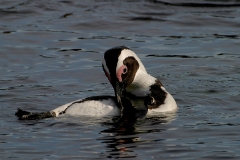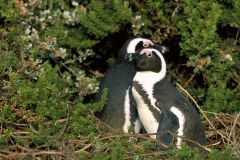African Penguins
The Africa penguins that shared its rocky shores with us during our stay on the Cape Peninsula of South Africa brayed like donkeys. Hence the common name of Jackass Penguin. To say they were loud would be a huge understatement. Their braying was deafening.
It was their springtime, and the first days of our African adventure. The grass and shrub covered dunes above the boldered beachfront provide burrows for raising their young. At first we thought we were seeing different morphs of the African (Jackass) Penguin, but further study of the guidebooks made it clear the grayer versions were immature birds. We slowly and calmly walked among them for days. They allowed us to move within a few yards of them.
The bird has some very interesting characteristics. When their bodies are feeling too warm, the patch of skin over their eyes provides a cooling affect. Blood flows there and releases heat, causing the patch to appear pink. The hotter the bird becomes, the pinker the patch appears.
Bolder Beach is famous for the African Penguin. While it is commonly seen there, and we enjoyed them by the dozens, the species is classified as endangered. The reasons are many, but just about all of them are related to environmental factors such as the decline of their food source – fish and squid. In the beginning of this century, there were estimated to be about 200,000 birds in existence. In 2012, that number was down to approximately 55,000. In 2015, the African Penguin and Seabird Sanctuary was opened. There is hope that the bird is a good candidate for captive breeding, but there are problems. The inland sanctuary has introduced avian malaria into the population. Over 27% of the bred birds die to this disease. Without intervention, however, it is estimated the species could go extinct within 15 years. This is the only breeding species of penguins in Africa.






